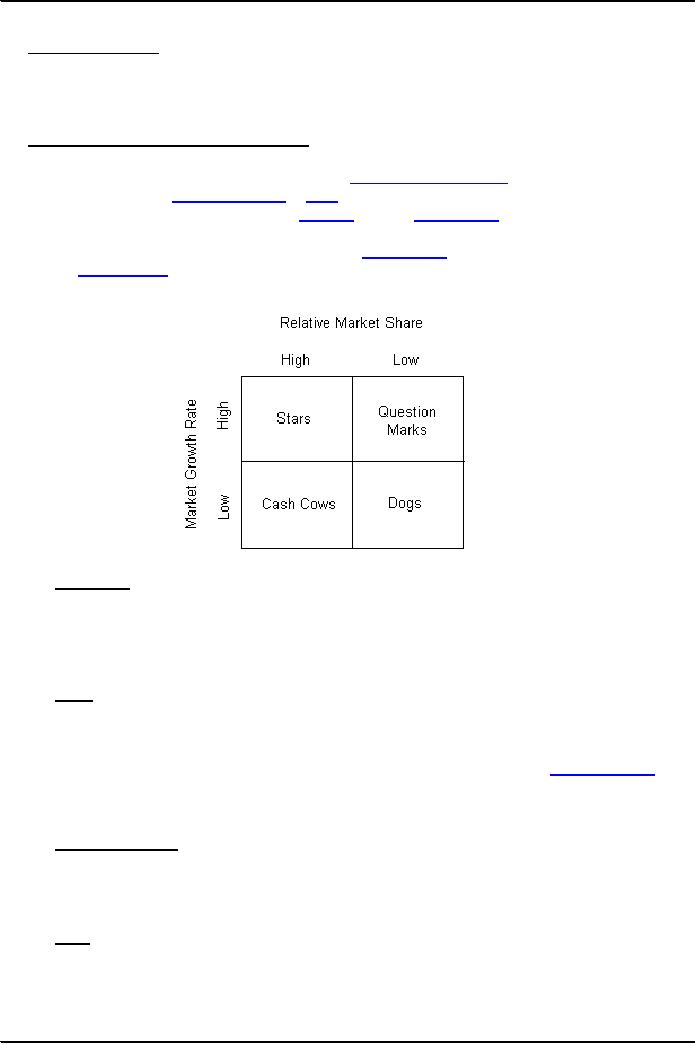 |

Strategic
Management MGT603
VU
Lesson
27
BOSTON
CONSULTING GROUP (BCG)
MATRIX
Learning
objective
After
understanding this chapter you are
able to understand BCG and
IE matrices and also
understand
how
to prepare these matrices
for any organization and what
its practical implementation in
various
organizations.
Boston
Consulting Group (BCG)
Matrix
The
Boston Consulting Group (BCG)
is a management
consulting firm
founded by Harvard
Business
School alum Bruce
Henderson in
1963.
The growth-share
matrix is a
chart created by
group
in
1970 to help corporation
analyze their business
units
or product
lines,
and decide where to
allocate
cash.
It was popular for two
decades, and is still used
as an analytical tool.
To
use the chart, corporate analysts
would plot a scatter
graph of
their business units, ranking
their
relative
market
shares and
the growth rates of their
respective industries. This led to a
categorization of
four
different types of
businesses:
�
Cash
cows Units
with high market share in a
slow-growing industry. These units
typically generate
cash
in excess of the amount of cash needed to
maintain the business. They are regarded
as staid
and
boring, in a "mature" market,
and every corporation would
be thrilled to own as many
as
possible.
They are to be "milked" continuously
with as little investment as possible,
since such
investment
would be wasted in an industry
with low growth.
�
Dogs
More
charitably called pets, units with
low market share in a
mature, slow-growing industry.
These
units typically "break even", generating
barely enough cash to maintain the
business's market
share.
Though owning a break-even
unit provides the social benefit of
providing jobs and
possible
synergies
that assist other business
units, from an accounting point of
view such a unit is
worthless,
not
generating cash for the
company. They depress a profitable
company's return
on assets ratio,
used
by many investors to judge
how well a company is being
managed. Dogs, it is thought,
should
be
sold off.
�
Question
marks Units
with low market share in a
fast-growing industry. Such business
units
require
large amounts of cash to
grow their market share.
The corporate goal must be to
grow the
business
to become a star. Otherwise, when the
industry matures and growth
slows, the unit will
fall
down into the dog's
category.
�
Stars
Units
with a high market share in
a fast-growing industry. The hope is that
stars become the
next
cash cows. Sustaining the
business unit's market leadership
may require extra cash, but
this is
worthwhile
if that's what it takes for the
unit to remain a leader.
When growth slows, stars
become
cash
cows if they have been able
to maintain their category
leadership.
103

Strategic
Management MGT603
VU
As
a particular industry matures and its
growth slows, all business
units become either cash cows
or
dogs.
The
overall goal of this ranking
was to help corporate analysts
decide which of their
business units to
fund,
and how much; and
which units to sell. Managers
were supposed to gain
perspective from this
analysis
that allowed them to plan with confidence to
use money generated by the
cash cows to fund
the
stars and, possibly, the question marks.
As the BCG stated in
1970:
Only
a diversified company with a
balanced portfolio can use
its strengths to truly
capitalize on its
growth
opportunities. The balanced
portfolio has:
�
Stars
whose high share and
high growth assure the
future;
�
Cash
cows that supply funds for
that future growth;
and
�
Question
marks to be converted into stars
with the added funds.
Practical
Use of the Boston
Matrix
For
each product or service the
'area' of the circle represents the
value of its sales. The
Boston Matrix
thus
offers a very useful 'map' of the
organization's product (or
service) strengths and
weaknesses (at
least
in terms of current profitability) as
well as the likely cash
flows.
The
need which prompted this
idea was, indeed, that of
managing cash-flow. It was reasoned
that one
of
the main indicators of cash generation
was relative market share,
and one which pointed to
cash
usage
was that of market growth
rate.
Relative
market share
This
indicates likely cash
generation, because the higher the share
the more cash will be
generated. As a
result
of 'economies of scale' (a basic
assumption of the Boston Matrix), it is
assumed that these
earnings
will grow faster the higher the share.
The exact measure is the
brand's share relative to
its
largest
competitor. Thus, if the brand had a
share of 20 per cent, and
the largest competitor had
the
same,
the ratio would be 1:1. If the
largest competitor had a
share of 60 per cent, however, the
ratio
would
be 1:3, implying that the
organization's brand was in a relatively
weak position. If the
largest
competitor
only had a share of 5 per
cent, the ratio would be
4:1, implying that the brand owned
was in
a
relatively strong position, which might
be reflected in profits and cash
flow. If this technique is
used
in
practice, it should be noted that this
scale is logarithmic, not
linear.
On
the other hand, exactly what is a
high relative share is a matter of
some debate. The best
evidence is
that
the most stable position (at
least in FMCG markets) is
for the brand leader to have a
share double
that
of the second brand, and treble that of
the third. Brand leaders in this position
tend to be very
stable
- and profitable
The
reason for choosing relative
market share, rather than just
profits, is that it carries
more
information
than just cash flow. It
shows where the brand is positioned
against its main
competitors,
and
indicates where it might be
likely to go in the future. It can
also show what type of marketing
activities
might be expected to be effective.
Limitations
1.
Viewing every business as a
star, cash cow, dog, or question
mark is overly
simplistic.
2.
Many businesses fall right
in the middle of the BCG matrix
and thus are not
easily classified.
3.
The BCG matrix does
not reflect whether or not various
divisions or their industries are
growing
over
time.
4.
Other variables besides relative
market share position and
industry growth rate in
sales are
important
in making strategic decisions about
various divisions.
Conclusion
After
discussion, the BCG matrix is an
important matrix regarding
strategy adopted by firm. Still
this
matrix
concern four strategy first
growth or build strategy
enhance market share),
second is hold
strategy
(hold existing position), third
Harvesting strategy (no further
growth or select
other
opportunity),
fourth is diversity (sell out the
part of business)
104
Table of Contents:
- NATURE OF STRATEGIC MANAGEMENT:Interpretation, Strategy evaluation
- KEY TERMS IN STRATEGIC MANAGEMENT:Adapting to change, Mission Statements
- INTERNAL FACTORS & LONG TERM GOALS:Strategies, Annual Objectives
- BENEFITS OF STRATEGIC MANAGEMENT:Non- financial Benefits, Nature of global competition
- COMPREHENSIVE STRATEGIC MODEL:Mission statement, Narrow Mission:
- CHARACTERISTICS OF A MISSION STATEMENT:A Declaration of Attitude
- EXTERNAL ASSESSMENT:The Nature of an External Audit, Economic Forces
- KEY EXTERNAL FACTORS:Economic Forces, Trends for the 2000’s USA
- EXTERNAL ASSESSMENT (KEY EXTERNAL FACTORS):Political, Governmental, and Legal Forces
- TECHNOLOGICAL FORCES:Technology-based issues
- INDUSTRY ANALYSIS:Global challenge, The Competitive Profile Matrix (CPM)
- IFE MATRIX:The Internal Factor Evaluation (IFE) Matrix, Internal Audit
- FUNCTIONS OF MANAGEMENT:Planning, Organizing, Motivating, Staffing
- FUNCTIONS OF MANAGEMENT:Customer Analysis, Product and Service Planning, Pricing
- INTERNAL ASSESSMENT (FINANCE/ACCOUNTING):Basic Types of Financial Ratios
- ANALYTICAL TOOLS:Research and Development, The functional support role
- THE INTERNAL FACTOR EVALUATION (IFE) MATRIX:Explanation
- TYPES OF STRATEGIES:The Nature of Long-Term Objectives, Integration Strategies
- TYPES OF STRATEGIES:Horizontal Integration, Michael Porter’s Generic Strategies
- TYPES OF STRATEGIES:Intensive Strategies, Market Development, Product Development
- TYPES OF STRATEGIES:Diversification Strategies, Conglomerate Diversification
- TYPES OF STRATEGIES:Guidelines for Divestiture, Guidelines for Liquidation
- STRATEGY-FORMULATION FRAMEWORK:A Comprehensive Strategy-Formulation Framework
- THREATS-OPPORTUNITIES-WEAKNESSES-STRENGTHS (TOWS) MATRIX:WT Strategies
- THE STRATEGIC POSITION AND ACTION EVALUATION (SPACE) MATRIX
- THE STRATEGIC POSITION AND ACTION EVALUATION (SPACE) MATRIX
- BOSTON CONSULTING GROUP (BCG) MATRIX:Cash cows, Question marks
- BOSTON CONSULTING GROUP (BCG) MATRIX:Steps for the development of IE matrix
- GRAND STRATEGY MATRIX:RAPID MARKET GROWTH, SLOW MARKET GROWTH
- GRAND STRATEGY MATRIX:Preparation of matrix, Key External Factors
- THE NATURE OF STRATEGY IMPLEMENTATION:Management Perspectives, The SMART criteria
- RESOURCE ALLOCATION
- ORGANIZATIONAL STRUCTURE:Divisional Structure, The Matrix Structure
- RESTRUCTURING:Characteristics, Results, Reengineering
- PRODUCTION/OPERATIONS CONCERNS WHEN IMPLEMENTING STRATEGIES:Philosophy
- MARKET SEGMENTATION:Demographic Segmentation, Behavioralistic Segmentation
- MARKET SEGMENTATION:Product Decisions, Distribution (Place) Decisions, Product Positioning
- FINANCE/ACCOUNTING ISSUES:DEBIT, USES OF PRO FORMA STATEMENTS
- RESEARCH AND DEVELOPMENT ISSUES
- STRATEGY REVIEW, EVALUATION AND CONTROL:Evaluation, The threat of new entrants
- PORTER SUPPLY CHAIN MODEL:The activities of the Value Chain, Support activities
- STRATEGY EVALUATION:Consistency, The process of evaluating Strategies
- REVIEWING BASES OF STRATEGY:Measuring Organizational Performance
- MEASURING ORGANIZATIONAL PERFORMANCE
- CHARACTERISTICS OF AN EFFECTIVE EVALUATION SYSTEM:Contingency Planning